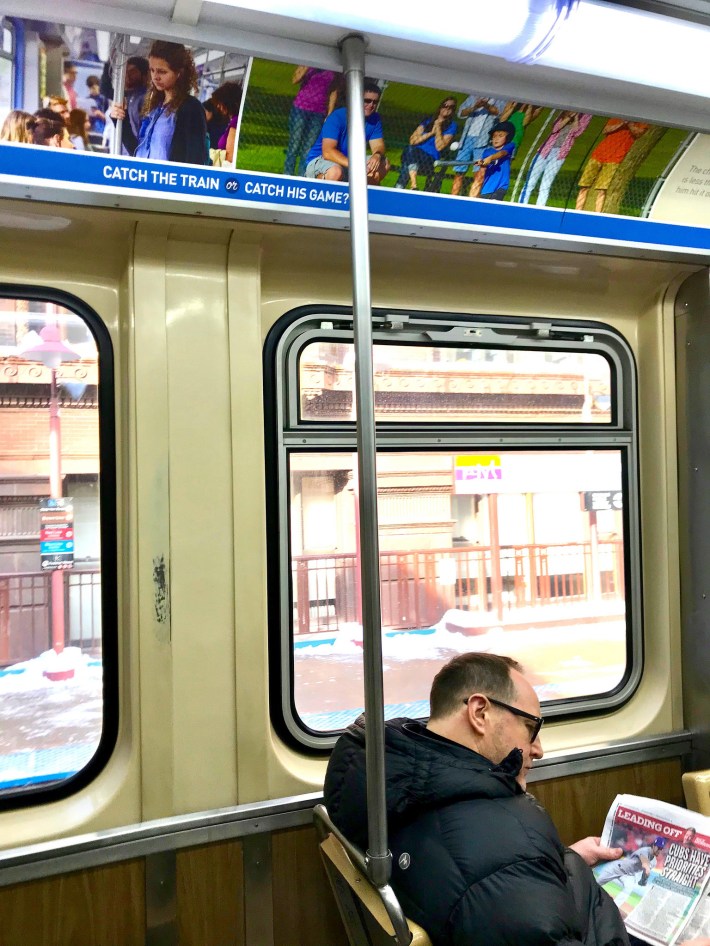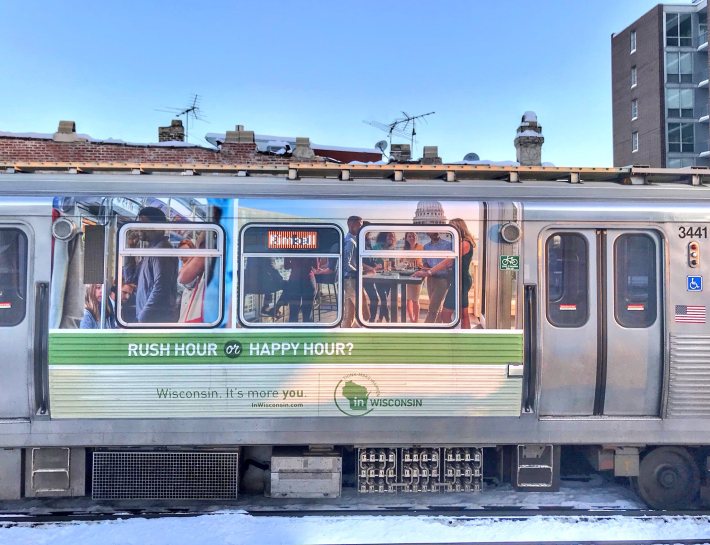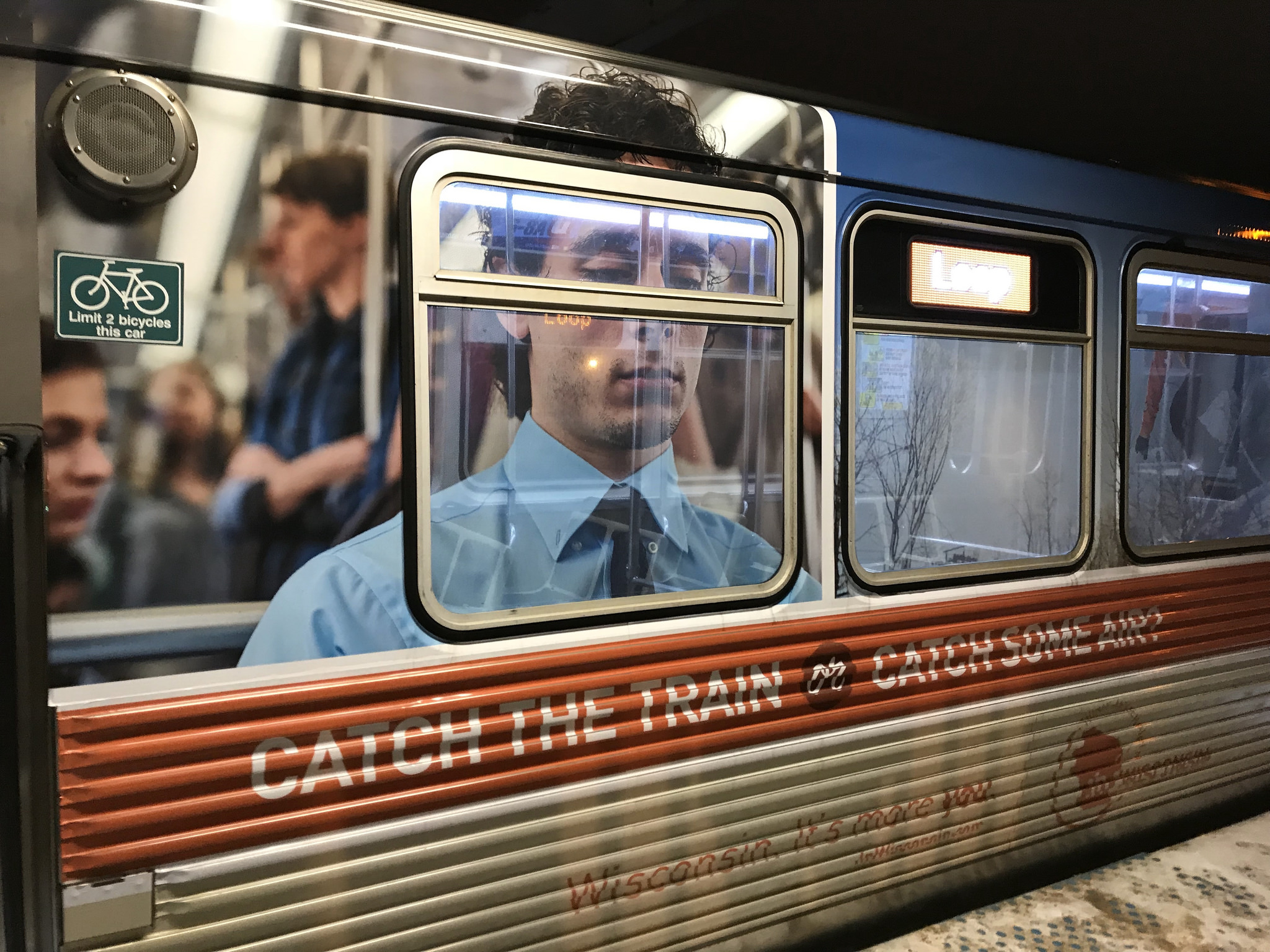Since Uber and Lyft have been cannibalizing CTA ridership lately, this would be a great time to promote the transit system as a cheap, efficient, green, and interesting way to get around town. But right now there are advertisements displayed on el platforms, and inside and outside of 15 Brown Line cars, showing young people looking miserable on CTA trains, along with text suggesting that rapid transit is a soul-crushing waste of time. What gives?
The ads are part of a $1 million marketing campaign from the Wisconsin Economic Development Corporation to entice Chicago millennials to move to the Badger State. The public-private agency was formed in 2011 by Republican governor Scott Walker, whose anti-transit policies have included refusing $810 million in federal grants lined up by his predecessor for a new passenger rail line linking Milwaukee and Madison.
Along with ads on social media, in downtown health clubs, and on beer coasters in local bars, the CTA images feature the tagline “Wisconsin: It’s more you,” i.e. a place where a lower cost of living, shorter commutes, and easy access to outdoor recreation means young adults can get more out of life. According to WEDC chief operations officer Tricia Braun, the campaign targets young Chicagoans “who wanted the urban experience but have since become disillusioned with the daily challenges.”

One ad states that “Chicago has the longest commute times in the country compared to only 22 minutes in Wisconsin” and asks the viewer if they’d rather be “Waiting for a train or waiting for kabobs” at a barbecue. Other placards on the CTA juxtapose dejected-looking young straphangers with shiny, happy people drinking beer on a terrace above Madison’s Lake Monona, playing Frisbee golf, or competing in beach volleyball. The accompanying text asks “Rush hour or happy hour?”, “An hour commute or an hour with friends?”, and “Bump elbows or bump on the court?”
The message is clear: The el is a drag, so you should move to Wisconsin, where you can drive everywhere instead. The question is, why is the CTA playing host to this anti-transit sentiment?
According to agency spokesman Jon Kaplan, they don’t have a choice due to First Amendment issues. He said the CTA’s advertising guidelines prohibit ads for illegal goods or services, plus those containing false information, hate speech, overtly political messages, or mature content, but “if ads meet our guidelines, we accept them.”
However, the rules also prohibit advertising that “tends to disparage the quality of service provided by the CTA, or that tends to disparage public transportation generally.” But Kaplan asserted that the WEDC ads “do not disparage CTA or transit, but instead promote Wisconsin.”

Merriam-Webster defines “disparage” as “to depreciate by indirect means,” so I’d argue that the images showing el riders in a state of existential angst do imply that rapid transit is something to avoid. So perhaps the CTA isn’t actually required to run the WEDC ads, but has opted to do so for financial reasons?
Martin Redish, a Northwestern professor of constitutional law, doesn’t think that’s the case. He even questioned whether the anti-disparagement clause is legal, since the CTA is a governmental agency. “A core notion of the First Amendment is that the government can’t suppress speech that criticizes it.”
If we assume that WEDC made the CTA an offer they couldn’t refuse, that leaves the question of whether the ad campaign’s strategy of comparing Wisconsin’s 22 minute average commute time to Chicago’s, 32.4 minutes, is a fair line of attack. Center for Neighborhood Technology director Scott Bernstein noted that that’s an apples-to-oranges, state-to-city comparison. However, Chicagoans who drive alone to work do have a significantly longer average commute than their Milwaukee counterparts, 32.6 minutes compared 20.6 minutes, according to recent Census data.

But the average length of a transit commute in the two cities is virtually the same, 43.4 minutes in Chicago compared to 42.4 in Milwaukee, Bernstein added. While commute distances are greater in Chicago, the traffic jam-immune el system levels the playing field, since the Milwaukee County Transit System doesn’t include rapid transit.
“It’s not so much that people are choosing to drive in Wisconsin, but rather that the choice of riding a train was taken away from them,” Bernstein said. “I have a really hard time looking at those ads and not being somewhat offended. My guess is that people in Wisconsin might be offended too.”
Indeed, former Madison mayor Dave Cieslewicz recently wrote in that city’s Isthmus free weekly that the ad campaign seems “premised on the notion that millennials would rather spend time stuck in traffic on the Milwaukee freeway system or on the Madison Beltline than riding the el.” He noted that nowadays about a quarter of U.S. 19-year-olds don’t have driver’s licenses. "It apparently never occurred to the WEDC that there are people who actually would rather ride a train than drive a car.”

I recently buttonholed a few such folks on the Brown Line to get their impressions of the campaign. “I love the CTA,” said preschool teacher DeAdra Estelle, 29, on the Armitage platform. “I don’t have a car and my commute is pretty easy.” Estelle added that while she feels the ads portray the el in a negative manner, she found them to be funny.
26-year-old software consultant Adam Stevens moved to Chicago from Whitefish Bay, a Milwaukee suburb. Waiting for a train at Diversey, he said he’s generally had positive experiences with the el. Stevens was skeptical of the WEDC’s strategy. “Being from Wisconsin, there are enough positives to play off of that we don’t need to focus on anything negative to get people to move up there.”
On the Belmont platform, environmental engineer Marta Grabowski told me the el factored into her decision to take her current job instead of one in a city with no rapid transit. “I don’t think [the ads are] going to persuade millennials to leave Chicago. I think young people, especially, like riding the train. It’s sort of a cool city thing.”
At the Irving Park stop, a 31-year-old banking industry employee named Thai told me he previously lived in Brew City, where he drove to work every day. “Milwaukee’s great, but the public transportation isn’t so great,” he said. “I actually prefer riding the el to driving, not having to sit in traffic. The CTA works perfectly for me.”
Judging from these responses, if the Wisconsin Economic Development Corporation wants to convince Chicago millennials to move, they should stop portraying the el as a hell ride and focus on promoting the things that America’s Dairyland does best: beer, brats, brie, and bouldering.






